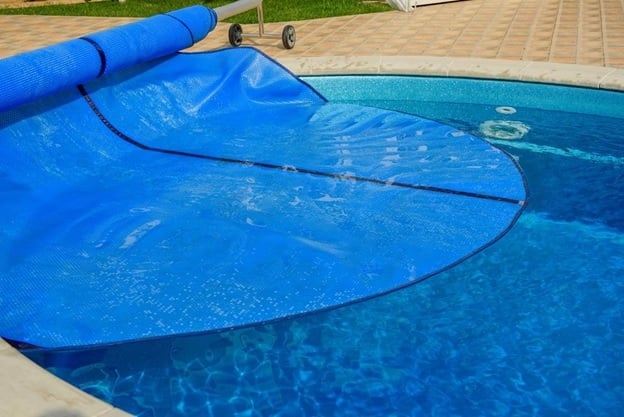Some of us have experienced the worst winters. Spring is no exception; it may even be the hottest day of the year. Having your pool ready for a dip while still not hot will allow you to swim sooner. Here are the proper steps in opening the pool:
Step 1: Remove the Pool Cover
Start the pool opening procedure by washing the cover. When removing the cover, make sure that leaves and twigs do not fall into your pool.
Rain-water or snow may have caught on the surface of a pool cover. The stagnant water becomes brownish in color with rotting plant materials. It is critical to pump away the contaminated water before it enters your pool. A wet-dry shop vacuum or a pump developed for this task can be extremely helpful.
Cleaning the cover while it’s still spread on the pool is easier. This is crucial since an exhaustive cleaning can help prevent mold from forming when you keep it.
You can rinse and remove a mesh-style pool cover without doing extensive cleaning. For an anchor-style cover, you’ll need to rinse it with a hose and scrub it using a soft bristle brush, depending on how dirty it is.
A word of caution: Using a pressure washer can damage a pool cover. Instead, invest in a car wash brush, which features a long fiberglass stick with soft bristles. This is available in many car supply stores or on the internet.

Step 2: Remove/Replace Plugs and Fittings
If you have winterized your pool, you will have blown out return lines. The skimmer line might have been filled with antifreeze in some parts. In addition, your pool’s skimmer may have been fitted with an ice compensator.
If you use an antifreeze to winterize your skimmer, you must remove it. Turn the handle of your multiport valve to “waste” if you are using a DE or sand filter. As the pump operates, most antifreeze will be pushed to the drain. To remove antifreeze from a cartridge filter, just use a vacuum on the skimmer line. By turning on the pool pump, any leftovers will be rinsed.
Change the return fittings. Put back all of the pump and filter plugs that were taken out during winterization. If you let somebody winterize the pool, the pieces might have been put within the pump basket by the pool technician.

Step 3: Clean the Pool
Cleaning the pool consists of three steps: brushing, skimming; and vacuuming.
Scrubbing the walls removes algae, staining, and scaling. Give special attention to “dead areas” such as steps, ladders, and skimmer.
Large pollutants can be removed by skimming the water’s surface with a net or leaf rake. These materials are unpleasant for swimmers and might fall to the bottom of your pool, causing discoloration.
Lastly, you have to vacuum the pool. To help you do this task, it’s better if you will use a robot vacuum.
If you don’t have a robot vacuum yet, consider buying one. This equipment is extremely helpful in removing dirt and debris on the water and the pool surface.
When buying a pool cleaner, consider these factors: type and size of the pool; stairs, steps, and walls; and the type of debris to be collected. In terms of features, you need intelligent scanning systems so that the machine can determine the best path, the right weight, anti-tangle swivels, and a filtration system. If you don’t have the time to study what kind of robotic pool vacuum you need, you can get one suitable for all types of pools.

Step 4: Refill the Pool
After cleaning, you can discharge the dirty and refill with a new one until the water level reaches half of the skimmer.
Step 5: Adjust the chemicals.
Using your test kit as a guide, adjust the alkalinity of your water to between 80 and 120.
After ensuring that the water is in the proper range, check the pH with a test kit to make sure it’s between 7.4 and 7.6. Meanwhile, ensure that the calcium hardness is between 200 and 400 parts per million.
The water balance is important to prevent algae growth and bacteria infestation and ensure that the water will not irritate the skin or cause allergies.
Most pool owners are confident in their ability to reopen their pools, but it’s not a bad idea to seek professional assistance. The steps involved in reopening your pool after the winter can be time-consuming. However, it is a crucial process to ensure that your pool is safe for everyone.





